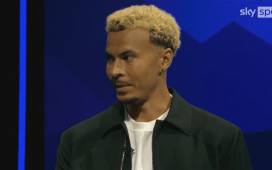 Image copyright
Image copyright
Shutterstock
Tommy Fury and Molly Mae are the bookies’ favourites to win
The people quickest to criticise Love Island are often those who haven’t actually watched it.
And it’s an easy show to throw stones at. On the surface it seems pretty superficial – good looking people, wearing bikinis, lying around in the sun, going on nice dates.
But the viewers who have been following the events of the villa for the last eight weeks have a “much deeper connection” (as the Islanders might say) to the series.
Here’s where we’re at, first of all. There are four couples left in the villa ahead of Monday night’s final. Only three of the remaining eight contestants have been in the villa since day one – Amber, Tommy and Curtis.
The favourites to win the £50,000 are Tommy Fury and Molly-Mae Hague. Like last year’s winners, Jack and Dani, they are the longest-running and seemingly most secure couple in the villa.
It’s by no means a done deal, however. Amber is widely regarded as having gone on the biggest journey, and Ovie also has a strong fan following.
But it barely even matters which couple wins. The prize money will be a fraction of how much the finalists will be able to earn in the next six months from brand deals, sponsored Instagram posts and nightclub appearances.
Image copyright
Shutterstock
Amber Gill is one of only three finalists to have stayed in the villa from day one
So what has made Love Island so successful in recent years? Perhaps most importantly, it’s relatable. The show is a microcosm of society, reflecting a contemporary dating culture which resonates with its young audience in particular.
“The dramas they go through, the conflicts they have to navigate, they’re things many of us have to navigate ourselves,” says Lucy Beresford, psychotherapist and author of Happy Relationships.
“So it appeals from an educational point of view, but there’s also a bit of schadenfreude – viewers think ‘thank goodness we haven’t made that much of a mess of some particular situation!’ And it’s also a brilliant way of seeing what not to do, the gaslighting that has gone on in the last couple of years – that kind of behaviour has been called out immediately.”
But unlike previous series of the show, there’s less of a focus now on the more physical elements of a relationship.
“Sorry but why is no-one having sex this year?” some viewers have asked on Twitter, recalling earlier series where some Islanders were seen having sex despite being surrounded by their fellow contestants. In comparison, the bedroom scenes this year have been much more PG.
“I think that’s partly to do with the show trying to evolve to becoming more mainstream,” says Rose Hill, senior TV writer at the Daily Mirror. “They want to go for something more family friendly.

Media playback is unsupported on your device
“But also I think the Islanders are much more aware of the implications of having sex on TV. In the 2016 series, Zara Holland lost her Miss Great Britain title and she said it ruined her life. And also with Dani Dyer winning last year, she never had sex with Jack on the show, which proved you don’t need to do that in order to win.”
Fortunately, there are plenty of other things to keep viewers entertained instead. The producers are skilled in the art of coming up with just the kind of tasks that really get inside the Islanders heads.
Tasks like The Snogathon or The Sidebar of Shame are designed to make the contestants second guess themselves, destabilise their relationships, or consider how they’re coming across to viewers.
Such tasks are part of the reason ITV has considerably improved its aftercare package, to make sure the Islanders have the mental health support they need to process not only what they’ve been through but also their new-found fame.
After leaving the villa this year, Amy Hart said she “couldn’t fault the support” provided by the team. “I’ve got 14 months of therapy guaranteed, but if I need it afterwards I can still have it. [The aftercare] is amazing,” she told Grazia.
The dramas and the tasks have helped this series of Love Island reach a consolidated audience of more than six million. The biggest episode of the series, which showed the fallout from Casa Amour, broke ITV2’s all-time ratings record.
Image copyright
Global
Contestants, such as Lucie Donlan, do a whirlwind media tour upon leaving the villa
And that doesn’t take into account those who watch short clips from the show online. This year’s most viewed video was seen by 1.5 million on YouTube alone.
So who is watching Love Island? The viewer breakdown for the 3 July episode (the one that broke the ratings record) offers some clues.
- Around 58% of viewers are female
- More than half the audience is aged between 16 and 34
- Three-quarters of the audience are in the so-called C2DE bracket – the three lower social and economic groups
- More than a quarter (29%) of viewers live in the north of England. That’s followed by the midlands (22%) and London (16%). It’s somewhat less popular in Scotland (8%) and Wales (4%) – although both obviously have smaller populations
In other words, it reaches demographics other shows can’t reach – young, underserved, female audiences. And that’s hugely valuable to advertisers.
Several issues raised this series have kept those viewers coming back night after night. Beresford praises “the emotional intelligence of the slightly older men this year, like Ovie”, but also highlights “the issue of the girl code, and whether it gets warped in any way”.

Media playback is unsupported on your device
“Early on this series there was a quite unpleasant trio of Amber, Anna and Amy,” she says. “And they really ganged up on people in the villa, men and women. But they used the phrase ‘girl code’ [to excuse it]. And I think it has highlighted the way in which the girl code does work, but also the way it’s often misused.
“There’s also been some comment about when Anna challenged Jordan. In effect you had six or seven girls haranguing Jordan, and you could never imagine that happening the other way around. So there has been something less than attractive about the girl code that’s been presented in this series.”
But Beresford welcomes the fact that such issues prompt conversation among viewers. She also applauds the way some Islanders have coped with rejection. “There was the conversation Curtis had with Francesca – and I thought Francesca handled that very elegantly,” she recalls.
It’s going to be quite a ride for the finalists when they leave the villa on Monday night. Most will go on a whirlwind tour of media interviews before deciding which brand deals they want to sign.
But now that the show is increasing to two series a year, most will be watching to see whether there’s enough audience appetite for double the dating.
“I’m not sure, because you never want too much of something – even Love Island,” says Hill. “If there are two series a year I’m not sure people are going to be quite as invested, they may get bored of it.
“Big Brother introduced two series in the Channel 5 years, and the January one was considered the better one, and in the summer people tuned out a bit, so it’ll be interesting to see which Love Island has the better viewing figures.”













